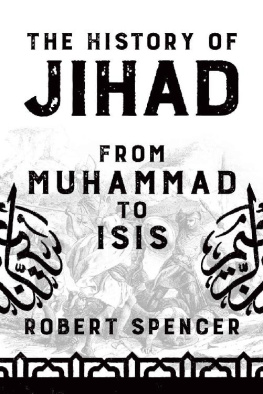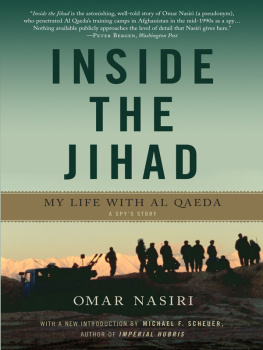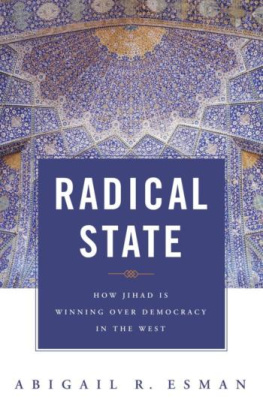No part of this book may be reproduced or utilized in any form or by any means, electronic or mechanical, including photocopying and recording or by any information storage and retrieval system, without the written permission of the author.
Self published book.
Introduction
We are confronted today with the seemingly intractable scourge of Islamic Terrorism. Some experience it in-person, most encounter the spectacle of it on their television screens. Our minds are haunted by images of 9/11, of the Bali nightclubs, of subways in Madrid and London, and of schoolchildren in Beslan. We witness daily misery in myriad locations around the globe. Jihadists behead innocent people on videotape, and billions watch it.
It has led decent people to ask questions and seek answers: What kind of person could do this?, What is the purpose?, What caused this and who is to blame? Naturally, we also ask, What can we do about it? Today, countless books are available about Islam and Islamic terror, and we do read them. Not long ago words like Sharia and Wahabbi would have met with blank stares from acquaintances. Now, while many readers are familiar with these terms, there still remains profound confusion about Islamism. A large percentage of non-Muslims continue to be mystified by an ideological cancer on the body of approximately 1.5 billion Islamic adherents.
Critics have leveled the charge at me that I am anti-Islam. Nothing is farther from the truth. I am in fact a Muslim and I consider much in Islam to be beautiful and worthwhile. However, the way it is taught today in most communities is perverted and destructive. Radical Islam could only have arisen in a community that prepared the ground for its evil seeds to sprout. I am convinced, therefore, that Islam is in need of reformation, or extensive re-interpretation, and that such change is entirely possible. To this end I have worked extensively, and in the final chapter I outline the key elements of Islamic reformation.
The 20th century bestowed upon us the carnage of the World Wars, Nazi concentration camps and Soviet labor camps. It has borne witness to genocide in places as disparate as Cambodia, Rwanda, and Bosnia. If we have gained anything from that experience, we would expect it to be the capacity to diagnose ideological and societal illnesses, to confront them and defeat them. Sadly, that expectation leads to disappointment. Recent events in Darfur testify to a spotty record of inaction, indifference, and misdirected blame, of ignorance and feigned ignorance.
So too is it the case with jihad. I hope, in writing this book, to employ my personal experience to clarify the problem of Islamic terrorism and to propose workable approaches to neutralize it. I am certainly familiar with the time constraints of most readers television, books, radio, and newspapers compete with the new media of blogs, email and instant messages to monopolize our spare moments as never before. I have therefore chosen to keep this book to a reasonable length, so that even the busiest members of our society may read it.
Note: I intentionally did not use traditional translations of the Quran as many of them do not convey the exact understanding of the verse. For this reason, I translated the Quranic verses from Arabic (my mother tongue) into English in a way to convey how the verse is understood and interpreted by most Islamic scholars.
Tawfik Hamid
28 January 2008
This is not a book about Islam it is a book about Islamism and how to combat it. We cannot confront the problem of Islamism, however, without a general mental picture of Islam. The reader will encounter various Arabic words and Islamic concepts and must have some familiarity with them if any discussion about the topic is to make sense. That is what these next few pages undertake. They are not a substitute for a complete and detailed exposition of the religion. That role is played by the many excellent books devoted to the subject, and to which the reader is encouraged to turn. Indeed, many commonly-available encyclopedias provide an adequate coverage of Islam if a reader lacks the time or inclination to examine a complete treatise. In turn, some readers may already be knowledgeable about Islam; they may safely skip this overview. Here, I will cover only the main structural components of the religion and corresponding terms which are critical to our discussion. With these constraints in mind, let us introduce Islam.
The word Islam means submission to God, or Allah. It is a monotheistic faith that originated in the 7th century with its prophet, Muhammad. The primary text is the Quran, which Muslims believe is the literal word of God transmitted to the Prophet by the angel Gabriel. The revelation of the Quran to Muhammad is marked by Islams holiest month, Ramadan. Muhammad was born in the Arabian Peninsula, an area holy to Muslims, who call it, in Arabic, the hijaz. The region encompasses the holy cities of Mecca and Medina. These cities are visited every year by millions of Muslims as part of their obligatory pilgrimage, known as the haj.
Initially, Prophet Muhammad faced persecution for his new faith. As time passed, he was able to gather adherents and control the city of Medina, where he established his authority. From there, he fought battles against the armies of Mecca with mixed results. Eventually, by employing a strategy of constriction and direct assault, Muhammad overcame the city with little struggle. During that time, a quarrel arose between the Jews of Medina and Muhammads followers, which led to the quick destruction of the Jewish community. This destruction, in combination with further conversion and conquest, enabled Muhammad to consolidate power. By the time of his death in 632, Muhammad ruled the entire hijaz. After his death, Muslims selected a prince, or caliph, to lead an Islamic government called the Caliphate. Historians distinguish between several caliphates. They were headquartered in various cities and were the source of some internal conflict, including that between Sunni and Shia which we still see today. However, under the first caliphs and remarkably, in less than 150 years Islam had exploded across the Middle East, North Africa, and parts of Europe in what is known as the Islamic Conquest. In a short span of time, many native languages and religions disappeared; they were swallowed-up by the Arabic language and Islam.
Because he was the final prophet, chosen to reveal Gods last message, and also because of his success, most Muslims consider the Sunna or words and deeds of Muhammad to be a foundational component of Islam. These exploits of Muhammad are recorded in chronicles known as hadith, a word employed in both the singular and plural sense (although hadiths is popular among English speakers).
The Quran itself is divided into 114 chapters, called suwar (more commonly referred to in the singular, sura, and in the anglicized plural, suras), which contain a total of 6236 poetic verses, or ayat. The word of God was revealed to Muhammad not at once, but over a period of time. Therefore, earlier suras typically concern themselves with spiritual and ethical matters, while later suras are preoccupied with regulation of society, for example, marital relations, criminal punishment, and war. The Quran cannot cover every aspect of Islamic life, so many Muslims look to the







